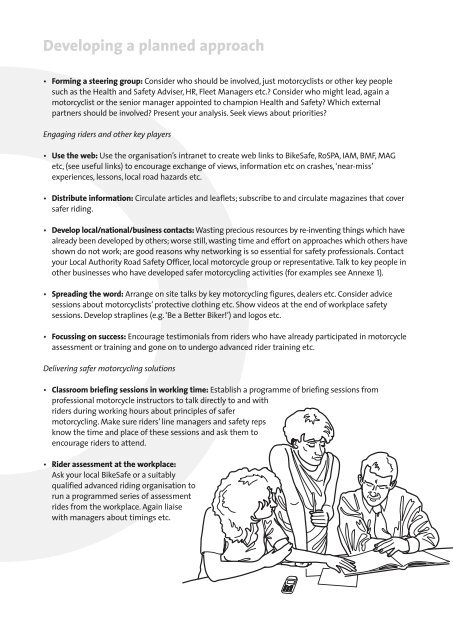Safer Motorcycling Through Work - Network - Motorcycle Action Group
Safer Motorcycling Through Work - Network - Motorcycle Action Group
Safer Motorcycling Through Work - Network - Motorcycle Action Group
Create successful ePaper yourself
Turn your PDF publications into a flip-book with our unique Google optimized e-Paper software.
Developing a planned approach<br />
• Forming a steering group: Consider who should be involved, just motorcyclists or other key people<br />
such as the Health and Safety Adviser, HR, Fleet Managers etc.? Consider who might lead, again a<br />
motorcyclist or the senior manager appointed to champion Health and Safety? Which external<br />
partners should be involved? Present your analysis. Seek views about priorities?<br />
Engaging riders and other key players<br />
• Use the web: Use the organisation’s intranet to create web links to BikeSafe, RoSPA, IAM, BMF, MAG<br />
etc, (see useful links) to encourage exchange of views, information etc on crashes,‘near-miss’<br />
experiences, lessons, local road hazards etc.<br />
• Distribute information: Circulate articles and leaflets; subscribe to and circulate magazines that cover<br />
safer riding.<br />
• Develop local/national/business contacts: Wasting precious resources by re-inventing things which have<br />
already been developed by others; worse still, wasting time and effort on approaches which others have<br />
shown do not work; are good reasons why networking is so essential for safety professionals. Contact<br />
your Local Authority Road Safety Officer, local motorcycle group or representative. Talk to key people in<br />
other businesses who have developed safer motorcycling activities (for examples see Annexe 1).<br />
• Spreading the word: Arrange on site talks by key motorcycling figures, dealers etc. Consider advice<br />
sessions about motorcyclists’ protective clothing etc. Show videos at the end of workplace safety<br />
sessions. Develop straplines (e.g.‘Be a Better Biker!’) and logos etc.<br />
• Focussing on success: Encourage testimonials from riders who have already participated in motorcycle<br />
assessment or training and gone on to undergo advanced rider training etc.<br />
Delivering safer motorcycling solutions<br />
• Classroom briefing sessions in working time: Establish a programme of briefing sessions from<br />
professional motorcycle instructors to talk directly to and with<br />
riders during working hours about principles of safer<br />
motorcycling. Make sure riders’ line managers and safety reps<br />
know the time and place of these sessions and ask them to<br />
encourage riders to attend.<br />
• Rider assessment at the workplace:<br />
Ask your local BikeSafe or a suitably<br />
qualified advanced riding organisation to<br />
run a programmed series of assessment<br />
rides from the workplace. Again liaise<br />
with managers about timings etc.


